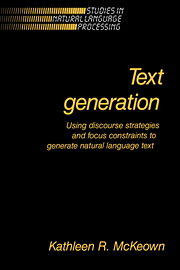Book contents
- Frontmatter
- Contents
- Preface
- 1 Introduction
- 2 Discourse Structure
- 3 Focusing in discourse
- 4 TEXT system implementation
- 5 Discourse history
- 6 Related generation research
- 7 Summary and conclusions
- Appendix A Sample output of the TEXT system
- Appendix B Introduction to Working
- Appendix C Resources used
- Appendix D Predicate Semantics
- Bibliography
- Index
4 - TEXT system implementation
Published online by Cambridge University Press: 23 December 2009
- Frontmatter
- Contents
- Preface
- 1 Introduction
- 2 Discourse Structure
- 3 Focusing in discourse
- 4 TEXT system implementation
- 5 Discourse history
- 6 Related generation research
- 7 Summary and conclusions
- Appendix A Sample output of the TEXT system
- Appendix B Introduction to Working
- Appendix C Resources used
- Appendix D Predicate Semantics
- Bibliography
- Index
Summary
A portion of an Office of Naval Research (ONR) database was used to test the TEXT system. The portion used contains information about military vehicles and weapons. The ONR database was selected for TEXT in part because of its availability (it had been in use previously in a research project jointly with the Wharton School of the University of Pennsylvania) and in part because of its complex structure. Even using only a portion of the database provided a domain complex enough to allow for an interesting set of questions and answers.
As discussed in Chapter One, TEXT accepts three kinds of questions as input. These are:
What is a <e>?
What do you know about <e>?
What is the difference between <e1> and <e2>?
where <e>, <e1>, and <e2> represent any entity in the database. Since the TEXT system does not include a facility for interpreting English questions, the user must phrase his questions in the functional notation shown below which corresponds to the three classes of questions.
(definition <e>))
(information <e>)
(differense <e1> <e2>)27
Note that the system only handles questions about objects in the database. Although the system can include information about relations when relevant to a question about a particular object, it can not answer questions about relations themselves.
System components
The TEXT system consists of six major components: a schema selector, a relevant knowledge selector, the schema filler, the focusing mechanism, a dictionary interface, and a tactical component.
- Type
- Chapter
- Information
- Text Generation , pp. 83 - 170Publisher: Cambridge University PressPrint publication year: 1985



